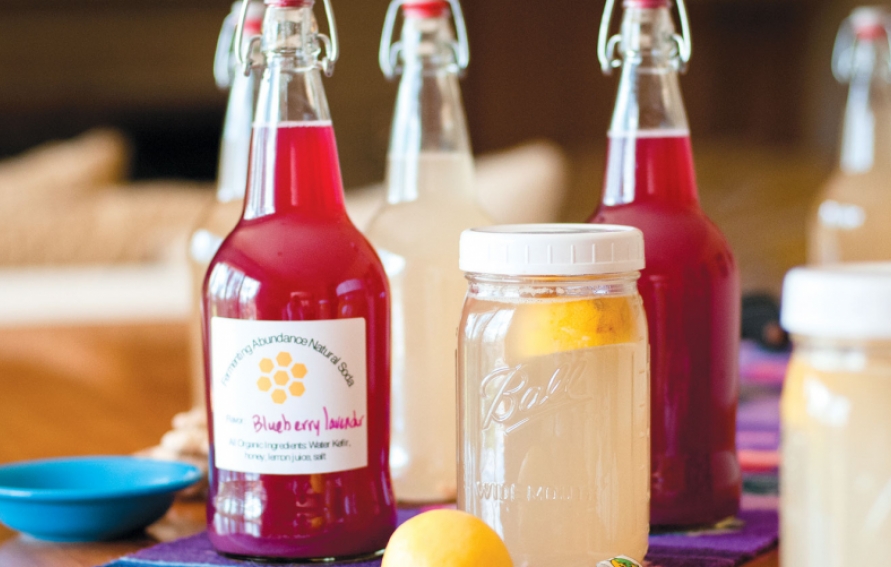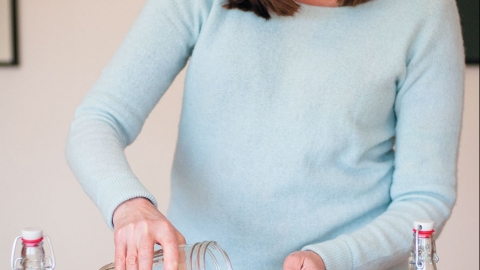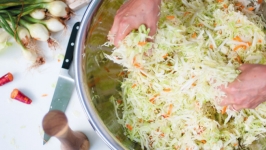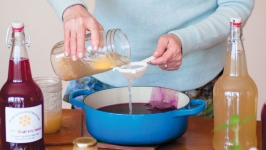Ingredients
- 2–4 tablespoon active water kefir grains (For dehydrated grains, read manufacturer’s instructions for reactivating.)
- ¼ cup organic cane or other natural sugar (Honey is not recommended in the first ferment.)
- 1 dried date, raisin or fig
- ½ lemon (optional)
- Spring water (filtered of chlorine but with minerals)
- Tools: 1 quart Mason jar, lid, coffee filter or cloth with rubber band, small strainer.
- 1 quart mature water kefir
- ¼ to 1 cup fruit juice or chopped fruit
- Tools: 1 large bowl, air-tight narrow-necked bottles (clear Grolsh-style wire bail bottles), funnel.
Preparation
The First Ferment: Water Kefir
1. Dissolve ¼ cup of sugar in 1 quart of warm filtered water.
2. Allow sugar water to cool until it is lukewarm. Excessive heat can kill your grains. After the water is cool, add the kefir grains, lemon, date, fig or raisin to the 1 quart Mason jar above.
3. Cover with a loose fitting lid or cloth and rubber band. This allows the culture to breathe while keeping out fruit flies and dust.
4. Place in a warm spot (but not in direct sunlight) for 24 to 48 hours. Longer than 48 hours may be taxing on the health of your kefir grains.
5. Drain your fermented sugar-water through a non-reactive fine mesh strainer to capture the grains. Set liquid aside. You may enjoy your water kefir at this first ferment stage, or continue on to the second ferment, creating a naturally fermented fizzy-flavored soda (see second step).
6. Putting the process on hold: When you need a break from brewing water kefir, the grains can be stored in fresh sugar-water and placed in the refrigerator for up to 1 week. This will slow the fermentation process.
When Is the Water Kefir Ready? Your water kefir should take between 1 to 3 days to fully ferment, depending on the temperature, the amount and health of the grains you use, the ingredients and the water quality. New starter grains will take longer, and may need a few generations to regain their full vigor.
The Second Ferment: Natural Fizzy Soda
1. In large pan combine fruit juice or fresh fruit to 1 quart water kefir (to taste) and stir to combine.
2. With a funnel, fill bottles with mixture, leaving about ¾ inch of headspace.
3. Cap, seal and set aside in a warm spot (but out of direct sunlight) for 2–3 days.
4. Release the bottles every day to allow the buildup of carbon dioxide to escape. This is very important as the pressure in the bottles has been known to cause a very big mess.
5. When your natural soda is sufficiently bubbly strain out any fresh fruit, refrigerate, cool and enjoy. Open carefully, as the liquid in the bottle is under pressure and may fizz and foam. The fermentation process is slowed in the refrigerator but not completely stopped.
About this recipe
What is Water Kefir, You Ask?
Water kefir is an amazing culture that is much like its more commonly recognized cousin, milk kefir, only it digests sucrose rather than lactose. This means that water kefir is perfect for fermenting sugar-water, transforming it into an effervescent, probiotic soda. Yes, a natural soda that is good for you. Both kefir cousins are made using a SCOBY (Symbiotic Colony of Bacteria and Yeast) commonly referred to as “grains” because of their granular structure. They are little, gelatinous clumps of microorganisms that can be strained out of your ferment and passed from batch to batch, perpetuating the line.
Naturally fermented water kefir is a traditional fermented drink that is easy to make. Fermentation time is short—just a couple of days. Kefir grains (like sourdough or kombucha) are a bit like a pet: they need to be fed on a regular basis to keep them active and alive. So while maintaining kefir grains may not be for everyone, these low-sugar, caffeine-free, cost-effective, probiotic-filled beverages are a refreshing and easy way to begin to add fermented foods into your diet.
Water kefir grains can be found from a local source through a friend, City Folks Farm Shop or through Cultures for Health.











